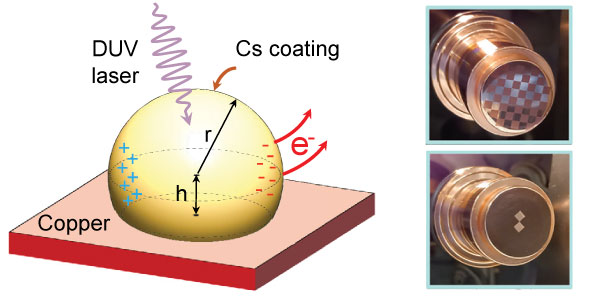Hot electron enhanced photoemission from laser fabricated plasmonic photocathodes
-
Photocathodes are an important element to improve on current particle accelerators.
-
Dr. Alejandro Manjavacas is responsible for the quantum model that describes the hot electrons generated by surface plasmons.
Madrid / November 13, 2023
A team of researchers belonging to CERN, the European Organization for Nuclear Research; at Department of Physics, Norwegian University of Science NTNU–Norwegian; to Department of Ultra-Precision Surfaces of the Leibniz Institute of Surface Engineering; and the CSIC Institute of Optics (IO-CSIC) has proposed a new approach to improve the efficiency of photocathodes, elements whose Performance is key in high-energy electron sources used in particle accelerators and other scientific applications. The study has been recently published in the journal Nanophotonics.
Latest news
What are photocathodes
A photocathode is a device that emits electrons when exposed to light, it is formed by a layer of a metallic substance, usually copper, on a base of quartz or glass. The number of electrons emitted is directly proportional to the amount of light that falls on the photocathode, which is why they are illuminated with high-power sources. However, conventional metal photocathodes have proven to have limitations in terms of quantum efficiency and lifetime.
To overcome these limitations, researchers have proposed the use of laser nanostructuring techniques on copper substrates to achieve the appearance of nanostructures capable of supporting surface plasmons. These excitations decay, generating the so-called “hot electrons”, which help to increase the quantum efficiency of the photoemission processes used in particle accelerators such as CERN and in X-ray and gamma-ray generators.

The team used laser nanoengineering to modify the surface of copper, creating nanostructures on its surface smaller than the optical wavelength. This modification allowed the aforementioned generation of hot electrons. The researchers performed experimental measurements to quantify the performance of the new plasmonic photocathodes in a typical CERN electron gun configuration. Experimental results revealed that plasmon-induced hot electrons led to a significant increase in the quantum efficiency of the photocathodes. An emitted charge enhancement factor of at least 4.5 and up to 25 was observed compared to standard metallic photocathodes. Another advantage of this new design is that plasmonic photocathodes can be easily produced “in situ” in the same electron gun in vacuum environments and without major interruptions. This could lead to unprecedented continuous and efficient operation of electron sources, which is of great interest in various scientific applications that require high-power electron beams.
Dr. Alejandro Manjavacas, responsible for the quantum model which describes hot electrons generated by plasmons on a metal surface, commented: “This study represents a significant advance in the development of more efficient and robust photocathodes capable of generating high-energy electrons, and may contribute to the improvement of technologies such as therapeutics. FLASH against cancer, the development of X-ray and extreme ultraviolet (EUV) sources, ultrafast photodetectors, solar energy harvesting systems or nanoscale light-to-heat transducers.”
This is a research work in which The following European research centers have participated:
CERN, European Organization for Nuclear Research, 1211 Geneva, Switzerland,
< a href="https://www.ntnu.edu/physics">Department of Physics, NTNU–Norwegian University of Science and Technology, NO-7491 Trondheim, Norway
Department of Ultra-Precision Surfaces, Leibniz Institute of Surface Engineering (IOM)
Institute of Optics (IO-CSIC), Higher Council for Scientific Research, 28006 Madrid, Spain
IO-CSIC Communication
cultura.io@io.cfmac.csic.es
Related news
Tunable bound states in the continuum in active metasurfaces of graphene disk dimers
Madrid / December 12, 2023A research team made up of researchers from the Institute of Structure of Matter and the Optics Institute of the CSIC, the...
Low-Loss Directional Coupler for the C, L and U Bands Based on Subwavelength Gratings
Madrid / November 28, 2023Researchers from the spin-off Alcyon Photonics, the Optics Institute of the CSIC and the CNRS of Paris-Saclay University...
Next scientific coffee by Pedro Corredera on July 20
Madrid / July 12, 2023This is the third talk of the course. On May 20, 2019, the new definitions of the SI units of measurement based on universal...





